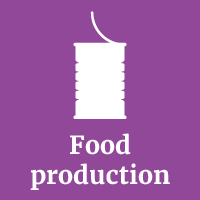
The Food Microbiome - Quiz
Since ancient times, fermented foods and beverages have been part of the human diet, for example, in the form of bread, wine, beer and cheese. How much do you know about these delicious and nutritious foods? Test your knowledge; maybe you know more than you think.
Food Microbiome Quiz
Question 1 |
How long have fermented foods existed approximately?
A | 1200 years |
B | 12.000 years |
C | 5000 years |
Question 1 Explanation:
Around 12,000 years ago, when people started to settle down and become farmers instead of constantly moving around to hunt and gather food, they discovered that fermentation, a process that involves the breakdown of substances by microorganisms, could help them in many ways to handle their limited food resources more effectively.
Question 2 |
Which are the most commonly used microorganisms in food fermentation?
A | Bacteria, yeast and moulds |
B | Yeast and Archae |
C | Moulds and Algae |
Question 2 Explanation:
Lactic acid bacteria, such as Lactobacillus and Streptococcus, are commonly used in the fermentation of dairy products like yoghurt and cheese. Saccharomyces cerevisiae is a yeast strain frequently used in bread-making, brewing, and winemaking. Penicillium, a type of mould, is used in the production of blue cheeses like Roquefort and Gorgonzola.
Question 3 |
What is NOT a fermented food product?
A | Cheese |
B | Yoghurt |
C | Milk |
Question 3 Explanation:
For cheese and yoghurt production, milk is being fermented. Milk in itself is not a fermented product.
Question 4 |
How are vegetables typically fermented?
A | Vinegar fermentation |
B | Alcohol fermentation |
C | Lactic acid fermentation |
Question 4 Explanation:
The most commonly used method to ferment vegetables is lactic acid fermentation, where fresh vegetables are salted and submerged in liquid (for example, in brine) or packed tightly in a fermentation vessel. This creates an environment for beneficial bacteria to convert the naturally occurring sugars in vegetables into lactic acid, preserving the vegetables and giving them a tangy flavour.
Question 5 |
What do you call the fermentation process that occurs in the absence of oxygen?
A | Aerobic fermentation |
B | Acetic acid fermentation |
C | Anaerobic fermentation |
Question 5 Explanation:
In anaerobic fermentation, it is important to ensure that oxygen cannot enter the fermentation process, as oxygen can promote the growth of undesirable microorganisms and hinder the growth of beneficial bacteria that drive the fermentation process. Therefore vegetables, which are typically fermented anaerobically, must be placed in a tightly sealed container so that oxygen cannot enter and the microbes can do their work.
Question 6 |
What typically happens to food during fermentation?
A | Microbes transform complex nutrients that are present in the food into simpler food components |
B | Microbes create more complex nutrients out of simpler food components |
C | Microbes turn existing food components into fat, creating the delicious taste of fermented foods |
Question 6 Explanation:
During the fermentation process, microbes transform macronutrients (sugars, proteins, fats) that are present in the food into simpler and often characteristically unique components. These byproducts contribute to the distinct flavours and aromas associated with fermented foods.
Question 7 |
What are the benefits of fermented foods?
A | Extended shelf life, better taste and improved texture |
B | Nutritional boost and digestive benefits |
C | All of these |
Question 7 Explanation:
Fermented foods are indeed superfoods! Not only do they have a longer shelf life by creating an environment hostile to harmful bacteria and mould, but they also offer a wide aroma palette and can have a more desirable texture than the foods from which they were made (crispier, more tender or creamier). On top, fermented foods offer health benefits, as they contain nutrients that are more easily absorbed by our bodies, and beneficial bacteria or probiotics that support gut health.
There are 7 questions to complete.
You have completed
questions
question
Your score is
Correct
Wrong
Partial-Credit
You have not finished your quiz. If you leave this page, your progress will be lost.
Correct Answer
You Selected
Not Attempted
Final Score on Quiz
Attempted Questions Correct
Attempted Questions Wrong
Questions Not Attempted
Total Questions on Quiz
Question Details
Results
Date
Score
Hint
Time allowed
minutes
seconds
Time used
Answer Choice(s) Selected
Question Text
All done
Need more practice!
Keep trying!
Not bad!
Good work!
Perfect!



